Caution: may pop
My long love affair with the American passionflower, Passiflora incarnata, started when I was a little kid. When I was visiting my grandparents in Kansas, my grandpa brought me home some of these gourds that he found while out helping his farmer friend bring in the cattle. They didn’t dry well. Later, I found the stunning, bizarre purple flowers when riding my bike, and looked them up and learned about them. I picked the fruits and ate them, juiced them, and made them into jelly. The most amazing jelly I ever made was wild elderberry, with passionfruit juice substituted for the lemon. YUM.
When I was grown up and had my own house, I discovered the many, many kinds of passionflowers that were available at plant nurseries, and I’ve raised, or at least attempted, over a dozen species and varieties. Only a few stuck with me, more because of Dallas’s beastly hot summers, than for the winter cold. For a couple of years, I had a good stand of the wild type, and enjoyed both their flowers and fruit. The others that I kept going for some years were P. caerulea and P. x Constance Elliott.
When we moved to the new house, I was happy to see that it already has some small P. lutea plants – these produce a tiny green-yellow flower, but they’re cool. I wanted to install some P. incarnata, though – and they’re not a plant you usually find in the nursery, so that meant a wander with a shovel.
I have often seen them on roadsides, and it’s an easy location to visit with a shovel and a bag. They don’t get a chance to climb upward much, but they ramble sidelong like boysenberries. I had thought I saw some when I was going from Old House to New House, but it’s in an inconvenient place to stop. Today, I got my little shovel and some bags, and went visiting.
I ended up with about fifty plants, and a pound and a quarter of fruit. I could have dug thousands without even putting a dent in the huge colony – the main limit was the number I could reasonably foresee taking care of. The plants spread by underground runners, and they are designed such that the plant breaks off if pulled; by digging and then then turning them out, you get a tuber with the top growth. These almost invariably grow, and are much more reliable and faster than cuttings.
The fruit, when full-sized, are roughly the size of hen’s eggs. This batch had a lot of small fruit, I think because the hillside had been mowed and it set the plants back. They are certainly tasty, though! These should not be allowed to wrinkle as much as the tropical variety; they will rot. They drop from the vine when ripe, so instead of picking them, I would lift and gently shake sections of vine. What falls, is mine.
I’ve read (somewhere) that the fruit got its name from the fact that the vines would pop out of the ground in late spring. They’re a hardy herbaceious perennial, coming back from the root every year. Anyone who has harvested them, knows that the real reason for the name, is that you almost invariably tread on some of the fruit, and they make a little bang as they burst.
Inside, they are not quite as gooey as the tropical version. The seed capsules are quite distinct, and if you don’t press them, you can handle them almost like pomegranate. They’re DELICIOUS. To say that the flavor is tropical, with hints of pineapple and banana, is like saying that garlic is like onion with a spicy aroma. But you get the right idea.
The seeds are quite hard and brown-black like iron, with little dimples. They don’t start as easily from seed as from roots, but they’re easier to share. After I got home and took pictures, I walked the neighborhood, eating the fruit and spitting the seeds on every vacant lot. Call me Johnny Passionflowerseed.
Let me know if you want some seeds – I’m going to have BUNCHES.

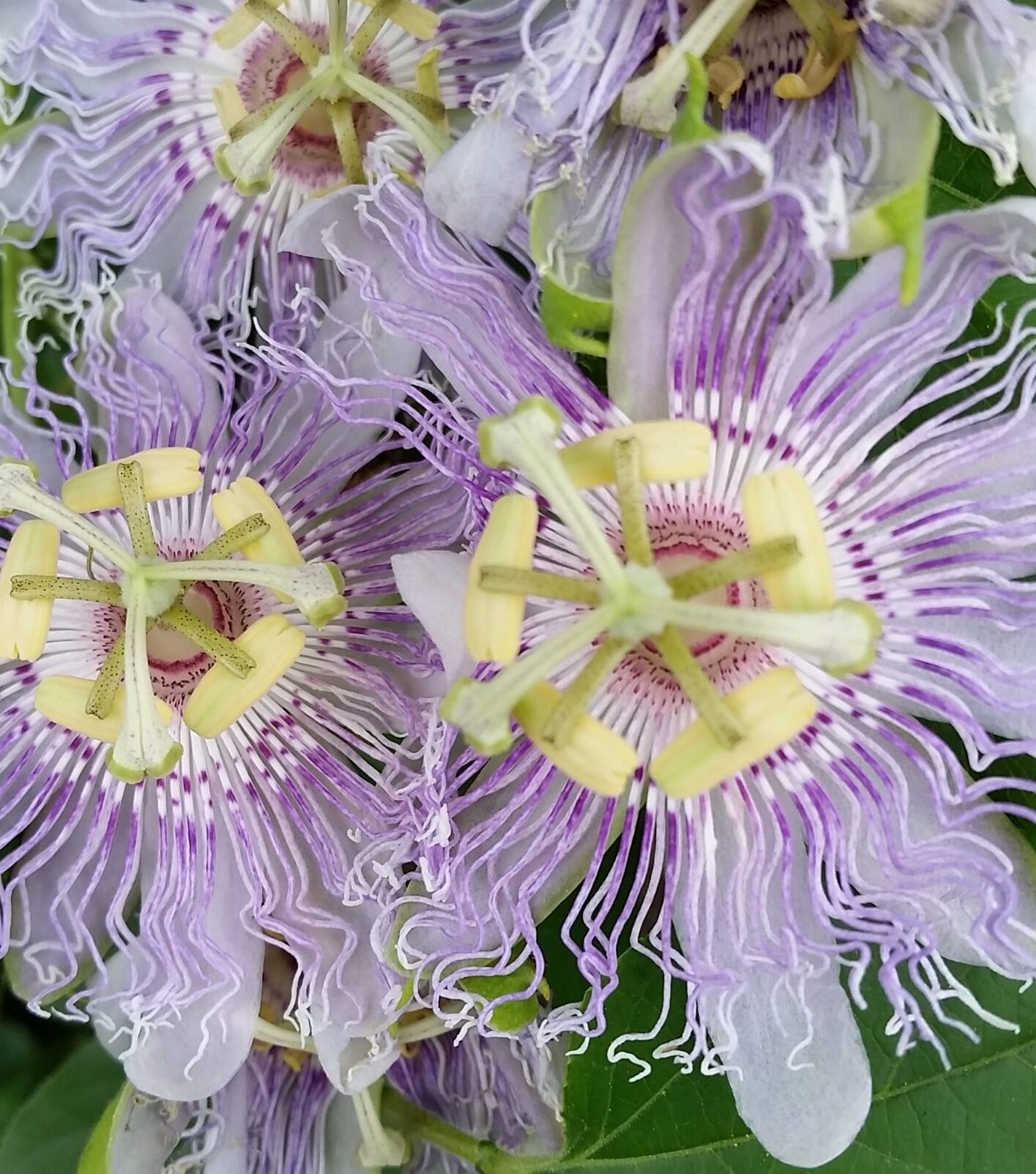
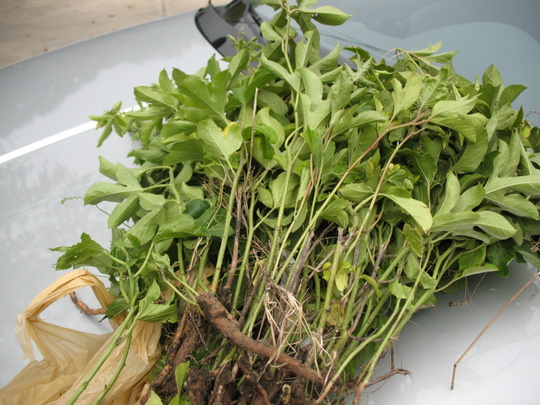
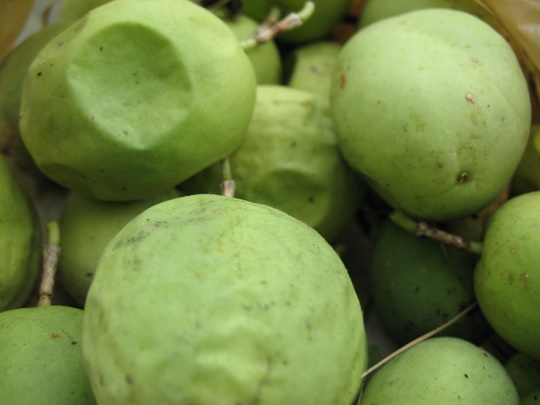
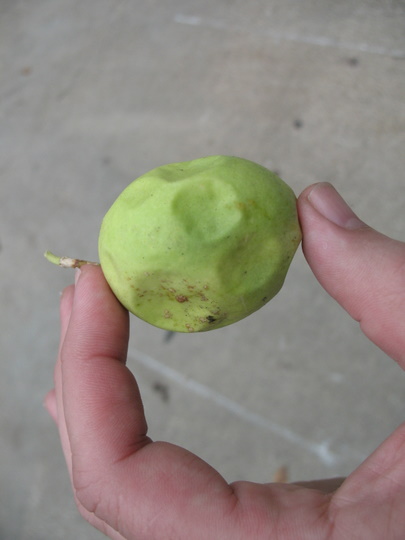
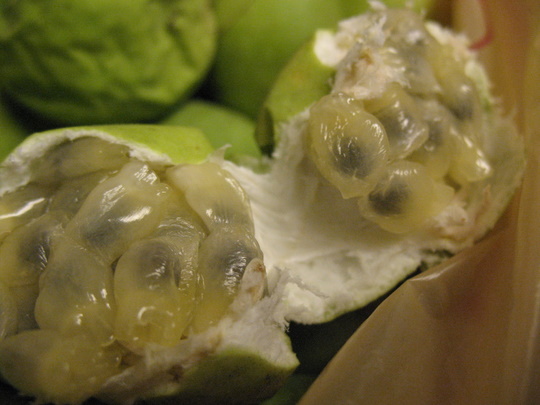
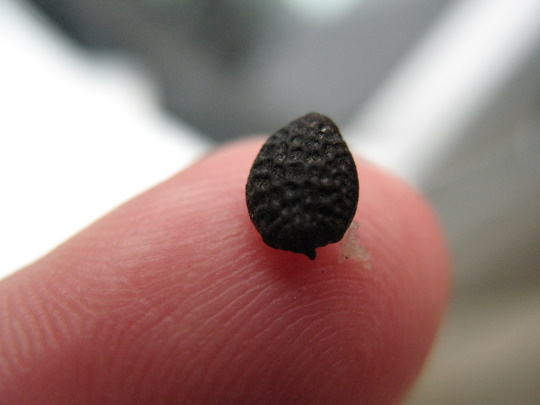
Wow I’ve never seen such a plant. It’s beautiful. 🙂
If you think they’d do well in Ohio, I’d love some.
I know we will want seeds, please. 🙂
I love passifloras! Can’t ever get fruit or seeds from them, though — the butterflies get them right after they start blooming and eat them down to nothing.
The trick with the seeds is to soak them in lemon juice for a day or two before planting. Works great.
Absolutely. What do I owe you?
Email me your mailing address: oakenking at gmail dot com
I know they do well through much of the US, and Wikipedia shows them being native to Ohio.
I’ve got some potted ones for Paul; they are SO much faster that way. If he ever wants to consider them as something to carry as a for-sale plant, the hillside site where I found them, probably an acre or more, has probably ten plants per square foot through much of it.
I tried to email you, but realized I don’t have your email. I’ve got some potted for you. Of course you’re welcome to as many seeds as you like – but the dug plants typically thrive very well, and it’s SO much faster.
If you want some fruit, it will probably only last a few days – not a long shelf life on this stuff – but I’ll have some at the office to share with my work friends. And I’m definitely making another visit, probably with basket but without shovel, to get more in a week or so; there were scads of unripe fruits.
<3 oh I love them! I used to have over a dozen varities of passifloras... my favorite is a hybrid, Ruby Red, but I love just about all of them.
I’ve, sadly, never eaten a maypop, we can’t grow them here (to fruit) it’s so funny, I was explaining the origin of “passion” flower to someone just today.
I’ve eaten a few varities though, they’re pretty amazing fruits.
Let me know where and when, and we’ll come to you. I have a good place to let the potted ones overwinter until I can get them in at the new place. Thank you.
I don’t know where your work is, but must be relatively near to mine… if you’ll email me, oakenking at gmail dot com, we can work out a meet-up…
Wow, those are gorgeous. I’ve never seen anything like that out here in California.
a lot of California nurseries carry some of the tropicals – of course, because they won’t freeze – but you probably never see the native types.
We had the flowers in Seattle, but they never fruited. Maybe we’ll have better luck in Virginia. I’ll send you my mailing address.
Thanks.
needless to say, yes, I would love some seeds! 😉
wow – I’ve never heard of these.
They don’t travel or store well at all, so you only hear about them if you’re in an area where people are out picking them. They’re all over Houston – I used to have several little groves that I would pick the fruit from, within bicycle distance.
Just email me at oakenking at gmail dot com – it looks like I’ll have quite a batch to post!
I’d also love to have some seeds! I’ve only once seen one in real life and I was so stunned by it. When I was dealing with my mom’s estate I went to check the mailbox one day and there were several on the fence at the end of the driveway. I took a few photos, but didn’t have time to try to transplant them and take them with me.
cool!!
Oh gosh, that makes me miss home so much. We had tons of lilikoi vines in our yarn when I lived in Kona.
Hmmm. I wonder if I could keep them alive in Northern VA.
Thanks for sharing!
that’s one of my favorite flowers! so trippy alien & perfect geometry. Growing up though ours never fruited.. i had no idea you could eat them… or that “passionfruit” was the same thing??
There’s a hybrid called “Incense” that almost never fruits; maybe it was one of those? Darker purple?
So pretty. I was just googling pictures a month ago and wondering if they’d grow in Arizona.
Howdy, Mr Passionflowerseed! Thanks for the informative post!
I want to thank you again for the dance at The Round Up! You’re a terrific dancer and partner! You floored me when you recognized me out of context:) My ride was leaving, so please forgive the wave goodbye from the dance floor steps! I hope our paths cross again!
HUGS!
Oooooo, passionfruit is one of my all time favorite flavors. I doubt it would overwinter here in central NJ, but I’d love to try.
i want to marry you. i’ll marry you and Chris.
does Tx allow that? to a canadian?
I developed a passion for the passion flower at about 9 when my grandmother introduced me to it on a fishing trip.
I’ll have to look into it. Thanks.
I love them too!
This one in my userpic was developed by my Uncle (Patrick Worley) and *blush* named for me!
How cool! I want to be remembered in binomial nomenclature…
It doesn’t produce fruits, but it is blooming like crazy right now!
Someone on my flist posted this link this morning and I thought you might be interested (if you haven’t already heard about it yourself). It’s a series of photos covering the exhibition of spider silk tapestry at the American Museum of Natural History in NYC. Amazing!